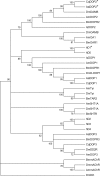Dopamine receptor antagonists as new mode-of-action insecticide leads for control of Aedes and Culex mosquito vectors
- PMID: 25793586
- PMCID: PMC4368516
- DOI: 10.1371/journal.pntd.0003515
Dopamine receptor antagonists as new mode-of-action insecticide leads for control of Aedes and Culex mosquito vectors
Abstract
Background: New mode-of-action insecticides are sought to provide continued control of pesticide resistant arthropod vectors of neglected tropical diseases (NTDs). We previously identified antagonists of the AaDOP2 D1-like dopamine receptor (DAR) from the yellow fever mosquito, Aedes aegypti, with toxicity to Ae. aegypti larvae as leads for novel insecticides. To extend DAR-based insecticide discovery, we evaluated the molecular and pharmacological characteristics of an orthologous DAR target, CqDOP2, from Culex quinquefasciatus, the vector of lymphatic filariasis and West Nile virus.
Methods/results: CqDOP2 has 94.7% amino acid identity to AaDOP2 and 28.3% identity to the human D1-like DAR, hD1. CqDOP2 and AaDOP2 exhibited similar pharmacological responses to biogenic amines and DAR antagonists in cell-based assays. The antagonists amitriptyline, amperozide, asenapine, chlorpromazine and doxepin were between 35 to 227-fold more selective at inhibiting the response of CqDOP2 and AaDOP2 in comparison to hD1. Antagonists were toxic to both C. quinquefasciatus and Ae. aegypti larvae, with LC50 values ranging from 41 to 208 μM 72 h post-exposure. Orthologous DOP2 receptors identified from the African malaria mosquito, Anopheles gambiae, the sand fly, Phlebotomus papatasi and the tsetse fly, Glossina morsitans, had high sequence similarity to CqDOP2 and AaDOP2.
Conclusions: DAR antagonists represent a putative new insecticide class with activity against C. quinquefasciatus and Ae. aegypti, the two most important mosquito vectors of NTDs. There has been limited change in the sequence and pharmacological properties of the DOP2 DARs of these species since divergence of the tribes Culicini and Aedini. We identified antagonists selective for mosquito versus human DARs and observed a correlation between DAR pharmacology and the in vivo larval toxicity of antagonists. These data demonstrate that sequence similarity can be predictive of target potential. On this basis, we propose expanded insecticide discovery around orthologous DOP2 targets from additional dipteran vectors.
Conflict of interest statement
The authors have declared that no competing interests exist.
Figures






Similar articles
-
Comparative pharmacological characterization of D1-like dopamine receptors from Anopheles gambiae, Aedes aegypti and Culex quinquefasciatus suggests pleiotropic signaling in mosquito vector lineages.Parasit Vectors. 2016 Apr 6;9:192. doi: 10.1186/s13071-016-1477-6. Parasit Vectors. 2016. PMID: 27048546 Free PMC article.
-
A "genome-to-lead" approach for insecticide discovery: pharmacological characterization and screening of Aedes aegypti D(1)-like dopamine receptors.PLoS Negl Trop Dis. 2012 Jan;6(1):e1478. doi: 10.1371/journal.pntd.0001478. Epub 2012 Jan 24. PLoS Negl Trop Dis. 2012. PMID: 22292096 Free PMC article.
-
Evaluation of AaDOP2 receptor antagonists reveals antidepressants and antipsychotics as novel lead molecules for control of the yellow fever mosquito, Aedes aegypti.J Pharmacol Exp Ther. 2015 Jan;352(1):53-60. doi: 10.1124/jpet.114.219717. Epub 2014 Oct 20. J Pharmacol Exp Ther. 2015. PMID: 25332454 Free PMC article.
-
Declining malaria, rising of dengue and Zika virus: insights for mosquito vector control.Parasitol Res. 2016 May;115(5):1747-54. doi: 10.1007/s00436-016-4971-z. Epub 2016 Mar 2. Parasitol Res. 2016. PMID: 26932263 Review.
-
Gold nanoparticles - against parasites and insect vectors.Acta Trop. 2018 Feb;178:73-80. doi: 10.1016/j.actatropica.2017.10.021. Epub 2017 Oct 29. Acta Trop. 2018. PMID: 29092797 Review.
Cited by
-
Homology Modeling and Molecular Docking Approaches for the Proposal of Novel Insecticides against the African Malaria Mosquito (Anopheles gambiae).Molecules. 2022 Jun 15;27(12):3846. doi: 10.3390/molecules27123846. Molecules. 2022. PMID: 35744972 Free PMC article.
-
Characterization of an adulticidal and larvicidal interfering RNA pesticide that targets a conserved sequence in mosquito G protein-coupled dopamine 1 receptor genes.Insect Biochem Mol Biol. 2020 May;120:103359. doi: 10.1016/j.ibmb.2020.103359. Epub 2020 Mar 10. Insect Biochem Mol Biol. 2020. PMID: 32169582 Free PMC article.
-
Current Knowledge on Chemosensory-Related Candidate Molecules Potentially Involved in Tick Olfaction via Haller's Organ.Insects. 2023 Mar 18;14(3):294. doi: 10.3390/insects14030294. Insects. 2023. PMID: 36975979 Free PMC article. Review.
-
Inwardly Rectifying Potassium (Kir) Channels Represent a Critical Ion Conductance Pathway in the Nervous Systems of Insects.Sci Rep. 2018 Jan 25;8(1):1617. doi: 10.1038/s41598-018-20005-z. Sci Rep. 2018. PMID: 29371678 Free PMC article.
-
Genomic insights into the Ixodes scapularis tick vector of Lyme disease.Nat Commun. 2016 Feb 9;7:10507. doi: 10.1038/ncomms10507. Nat Commun. 2016. PMID: 26856261 Free PMC article.
References
-
- World Health Organization (2014a) Dengue and severe dengue—Fact sheet N°117. Available: http://www.who.int/mediacentre/factsheets/fs117/en/#. Accessed March 17, 2014.
-
- World Health Organization (2014b) Lymphatic Filariasis. Fact sheet N°102. Available: http://www.who.int/mediacentre/factsheets/fs102/en/. Accessed March 17, 2014.
-
- World Health Organization (2012a) World Health Organization's 2020 Roadmap on NTDs. Geneva: World Health Organization, WHO Press; 22 p. Available: http://whqlibdoc.who.int/hq/2012/WHO_HTM_NTD_2012.1_eng.pdf. Accessed June 26, 2014.
-
- World Health Organization (2012b) "WHO roadmap inspires unprecedented support to defeat neglected tropical diseases". who.int. World Health Organization, Geneva. Available: http://www.who.int/neglected_diseases/London_meeting_follow_up/en/. Accessed July 28, 2014.
Publication types
MeSH terms
Substances
Grants and funding
LinkOut - more resources
Full Text Sources
Other Literature Sources

